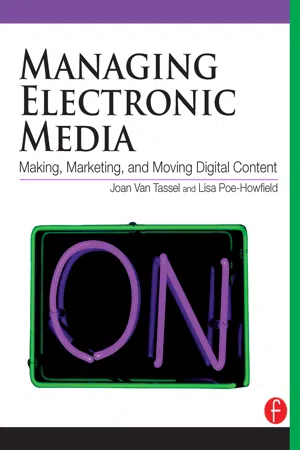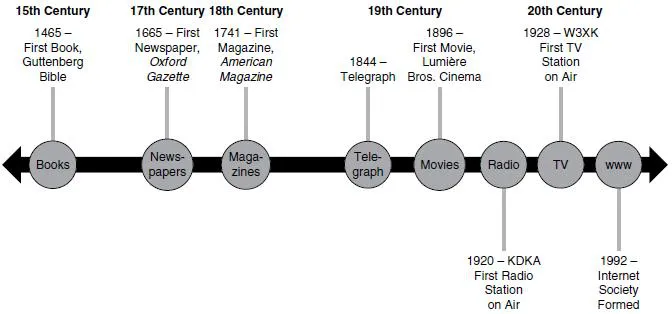CHAPTER 1
The Media Industries: Segments, Structures, and Similarities
don’t hate the media. Be the media.
Jello Biafra
CONTENTS
Chapter Objectives
Introduction
Structure and Characteristics of the Media Industries
A Day in the Life of Craig Robinson
Common Characteristics of the Segments of the Media Industries
Summary
What’s Ahead
Case Study 1.1 Media Expansion
Case Study 1.2 Planning Ahead for Success
References
Internet Resources
CHAPTER OBJECTIVES
The objective of this chapter is to provide you with information about:
- The structure and characteristics of the content industries
- The segments that make up the content industries
- The wide range of businesses within the segments of the content industries
- The changing cultural, social, political, and economic conditions that establish the business context of the content industries
INTRODUCTION
Movies, music, games, magazines, books, newspapers, Internet, comedy, drama, news - this media content constitutes the exciting visible face of the media world that thrills and enthralls audiences around the world. Many peo-ple have fantasies of being in the public eye as actors, singers, writers, and journalists, and a few of us go on to perform. But behind the scenes, there are many rewarding careers in the media industries to discover, promote, support, and manage all the activities that must be completed to bring these wonderful works to life and to audiences.
The history of electronic mass media is short. The precursors, books and news-papers, have been around for several hundred years, but the phenomenon of mass media is less than 150 years old. Electricity-based technologies have their roots in the nineteenth century, but all emerge as media platforms in the twen-tieth century, as shown in Figure 1-1.
FIGURE 1-1 Timeline of mass media platforms
The short lifetime of electronic media means that the structure of media com-panies evolved somewhat differently from businesses in older, industrial enter-prises. They standardized products and processes, seeking greater production efficiencies. Once developed, manufacturing may not change for several years. But each content product has at least some unique properties, such as episodes of television series, and others are entirely unique, including motion pictures and music albums. It is only at the point of distribution that content products are standardized for delivery and consumption.
At the same time, there are also many similarities between companies in the media industry and those in other sectors. Most of the work in media organiza-tions is initiated and supported by managers - executives who have responsi-bility for directing, controlling, and supervising the affairs of the enterprise. To carry out the work, they draw on all the human, financial, technological, and environmental resources available to them.1
For example, in television, when a show’s popularity begins to slip, network executives begin to think about developing a new product, a new show to air in that time period. They will ask producers and writers to submit ideas that would appeal to the audience, sift through those ideas, develop a few of them, pro-duce a couple of pilots, test the pilots with a panel of people who would be in the audience, and order episodes of the show they think will succeed. Similarly, music executives are always on the lookout for new talent, but they might think a performer in a particular genre - country, hip-hop, ethnic - might be more successful than an equally talented jazz musician or Romanian gypsy band. Managers work in every kind of organization, industry, geography, nation, and society. Their responsibilities have a great deal in common, whether the task is managing a chemical company, a large farm, a not-for-profit social service agency, or a music label. Yet each business enterprise and environment has its own characteristics that affect how managers conceptualize problems and solutions and how they carry out their duties.
The glamorous media industries are no exception - even routine, predictable work carries the patina of the power and visibility that surrounds these enter-prises. Human resources hire personnel - sometimes performers like Sean Penn. Legal departments negotiate and approve contracts - sometimes for albums like OK Computer by Radiohead. Business development units estab-lish partnerships, finance and accounting departments handle payables and receivables and impose organizational cost-reduction programs, and market-ing teams traverse the complex wholesale and retail channels that finally put products in the hands of consumers, for all produced content - even a compel-ling hit TV series like House.
STRUCTURE AND CHARACTERISTICS OF THE MEDIA INDUSTRIES
It is a given that managers will know a great deal about the industry in which they work. They get that information from many sources. Some media enter-prises gather and analyze information about their consumers and customers from direct contact. If they don’t have internal information, companies receive research reports that tell executives about their audience, product performance, and markets. There is a lot of public information as well, as the media are fre-quent subjects of journalistic coverage that report on financial, technological, and cultural aspects of the industry. Managers also gain valuable information from their own personal experiences with buying and consuming content.
Another factor that influences how managers make decisions is the importance of the media in people’s lives. Many spend more time watching, listening, and reading the media than they do anything else, except breathing. Adding up all of the time they engage with media - waking to the sound of the clock radio/ CD player and television set, checking and responding to email throughout the day, listening to a car radio and an iPod, watching a portable DVD, play-ing games on mobile phones, surfing the Net, and watching television before bed - the average person in the United States spends more than 9.5 hours per day with the media and will spend $936.75 per year on media consumption.2 Nine and a half hours is more time than most people spend sleeping! Given the amount of time devoted to media use, it is no surprise that the media exert profound cultural, economic, political, and psychological influences. Indeed, the media constitute a pervasive, virtual environment whose impact sometimes seems to transcend even the physical world. Managers find that their business can be affected by the content they provide - remember Janet Jackson’s “wardrobe malfunction”? It upset many viewers, resulting in fines for the network and electronic banishment for Jackson.
Industry Size and Composition
In 2011, the global media industries will account for nearly $2.0 trillion in rev-enue.3 However, they are part of a larger commercial complex, called the copy-right industries. The organizations that make up the copyright industries engage in the “generation, production and dissemination of new copyrighted mate-rial.”4 The specific content may differ, but the management of these activities is strikingly similar, regardless of the specific industry segment or enterprise in which they take place.
Four components make up the copyright industries:
- Core industries: Industries whose primary purpose is to create, produce, distribute, or exhibit copyrighted materials, including broadcast, music, motion pictures, entertainment software, newspapers, and magazines, as shown in Figure 1-2.
- Partial copyright industries: Industries for which only some aspect or portion of the products qualify for copyright protection, such as the Ford Motor Company, whose cars may be patented, but not copyrighted. However, the brochures, TV spots, and other promotional materials the company produces are copyright-protected.
- Nondedicated support industries: Industries that provide distribution, marketing, and sales support to the copyrighted content economy, includ-ing transportation services, telecommunications services, wholesalers, and retail establishments. Examples of nondedicated support industries are telephone companies and Internet infrastructures that provide the trans-port networks for content.
- Interdependent industries: Industries that manufacture and sell prod-ucts that enable the creation, production, distribution, or consumption of copyrighted material. Such industries include manufacturers of consumer electronics products and media - televisions, DVD players, game consoles, cameras, microphones, lighting equipment, discs and tape, headphones, and so forth - the technologies that depend on the copyright industries for content that drive consumers to buy playback devices.
Media companies make up the largest component of the core copyright indus-tries. The primary purpose of these enterprises is to create, produce, market, and distribute books, newspapers, magazines, advertising, music and music media (records, CDs, and prerecorded tapes), motion pictures, television and
FIGURE 1-2 The core copyright industries
COPYRIGHT
A legal framework that applies to original works that reserves the right of copying to the creator. Different countries have different legal frameworks that define these rights in different ways with respect to duration, enforcement mechanisms, and penalties for violation. In the United States, copyright is constitutionally protected.
radio programs, and computer software (including videogames). As shown in Figure 1-2 , the copyright industries are an important part of the U.S. economy and copyrighted products are the largest U.S. export.
In Europe, the copyright industries are equally important. In 2000, they con- tributed more than a trillion euros (€1,200 billion) to the EU economy - about 5.3 percent of its total value. And they employed more than 5 million people in the European Union, constituting 3.1 percent of the total EU workforce.5 In the United Kingdom, the importance of the creation of copyrighted material is even greater: creative industries account for 8 percent of the economy.6 Although there are many management jobs in the core industries, they also exist in large numbers in the support and interdependent industries. The par-tial copyright category is an interesting one for today’s job seekers. This cat-egory covers the media needs of enterprises that offer products and services in other industries: automobiles, clothing, cosmetics, fishing gear, restaurants, and car washing establishments. All these companies need material to commu-nicate to consumers, investors, and employees. Increasingly, these communica-tions include video and audio, which require more expertise and management supervision than print media.7
Industry Segments
People who work in one of the copyright industry segments usually think of themselves as being in the music business, television business, or movie busi-ness. In other words, they identify with the ...


